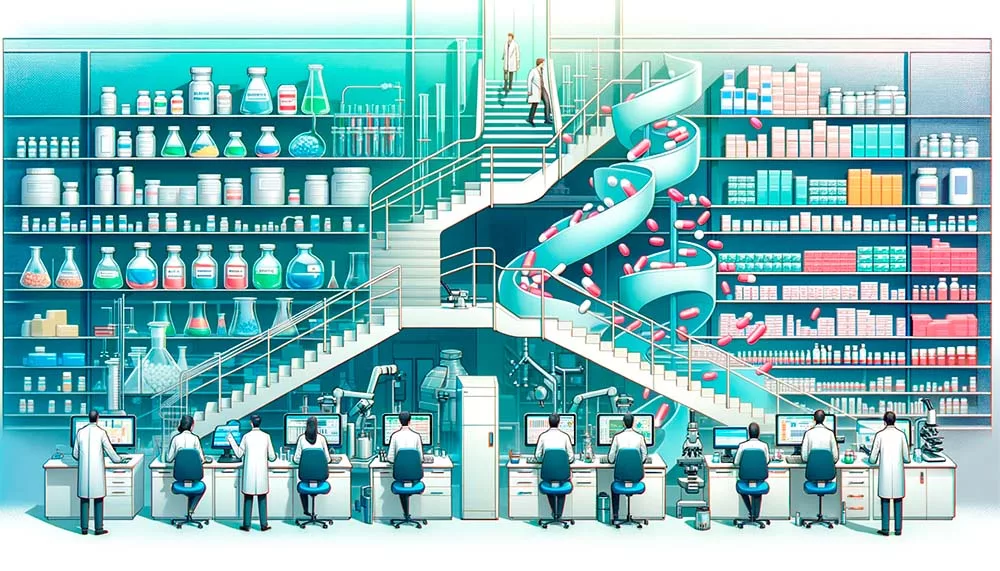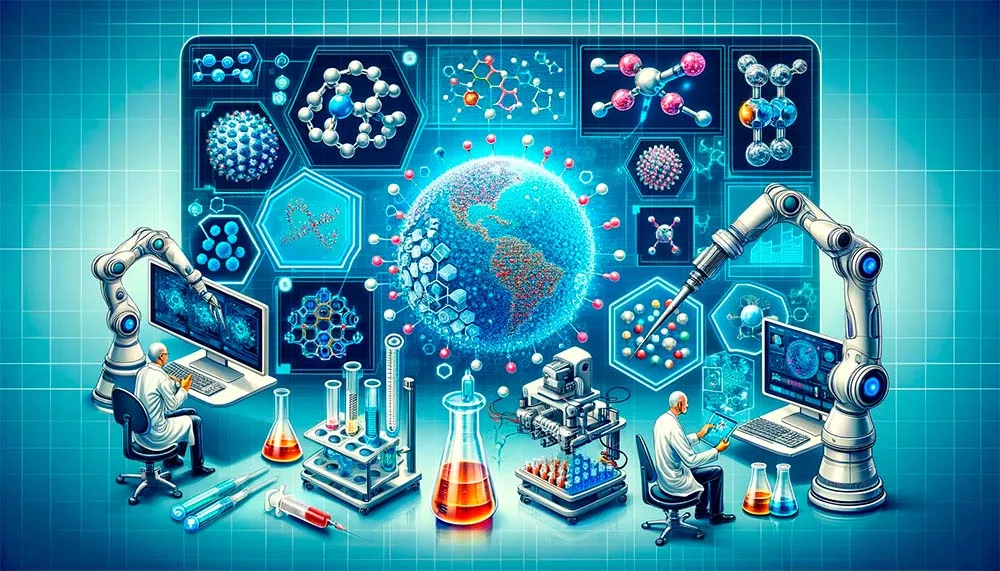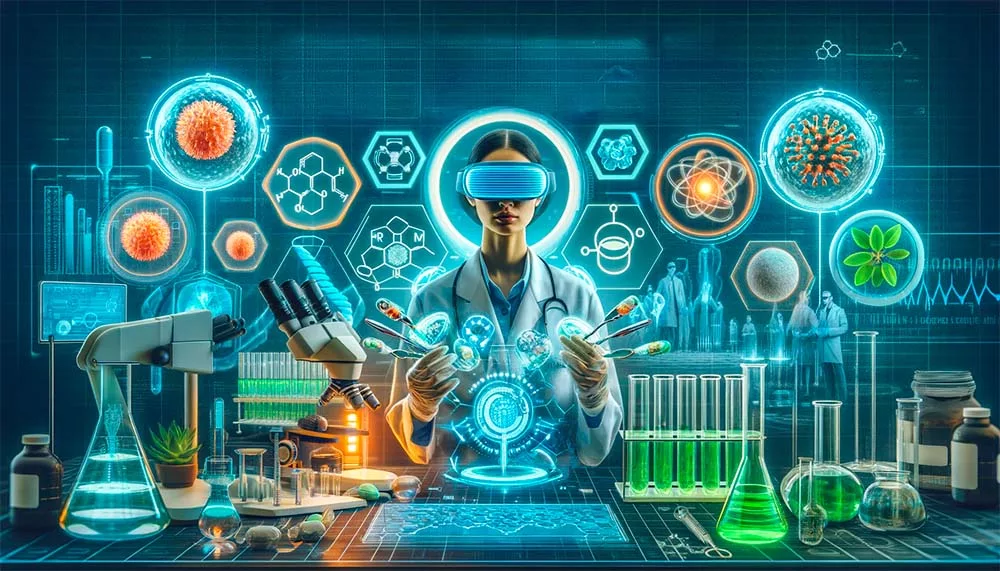What is R&D in Pharma?
Research and development

David Blok | Posted on January 11, 2024
- Introduction
- R&D Definition in Pharma
- From Ancient Remedies to Modern Medicine
- Key Components of R&D
- The Journey from Lab to Pharmacy Shelf
- Navigating the Hurdles in Pharma Research
- Technological Advances in Pharma R&D
- Regulation & Compliance in Pharma R&D
- Ethical Considerations in Pharma R&D
- Global Impact of Pharma R&D
- Investment in Pharma R&D
- Future Trends in Pharmaceutical R&D
- Conclusion
- FAQs
Introduction
Have you ever wondered how a simple pill can be a life-saver or how vaccines are developed so swiftly in times of a pandemic? The answer lies in the intricate and fascinating world of Research and Development (R&D) in the pharmaceutical industry. R&D is the backbone of pharmaceutical advancements, propelling us into an era of medical miracles and innovations. In this article, we’ll dive deep into the realm of pharmaceutical R&D, unraveling its layers and understanding its profound impact on global health.
R&D Definition
Research and Development (R&D) in Pharma: A Pillar of Innovation
R&D in the pharmaceutical sector is a complex, yet thrilling journey from concept to reality. It’s where science meets innovation to create breakthroughs in medicine. This journey involves a series of methodical processes aimed at discovering, developing, and bringing new medications to market. But why is R&D so pivotal in pharma? It’s the driving force behind new treatments and cures, bringing hope and healing to millions worldwide.
History of R&D in Pharma
From Ancient Remedies to Modern Medicine: The Evolution of Pharma R&D
The history of R&D in pharmaceuticals is as old as medicine itself. From the ancient practice of using herbs to modern-day sophisticated drug development, the journey has been revolutionary. The transformation began in earnest during the 19th and 20th centuries with the advent of modern chemistry and biology. This period marked the transition from traditional remedies to evidence-based pharmaceuticals, laying the foundation for today’s R&D.
Key Components of R&D
The Building Blocks of Pharmaceutical Research
Understanding the key components of R&D in the pharmaceutical sector is crucial. It’s a multidisciplinary field involving:
- Basic Research: Where it all begins, with fundamental research on diseases and potential treatments.
- Drug Discovery: Identification of promising compounds that could become new drugs.
- Preclinical Testing: Early-stage testing on cells and animals to assess safety and efficacy.
- Clinical Trials: Rigorous testing on humans in multiple phases to ensure safety and effectiveness.
- Regulatory Approval: Gaining approval from regulatory bodies like the FDA.
- Manufacturing: Scaling up production while maintaining quality.
- Post-Market Surveillance: Monitoring drug safety and efficacy in the real-world scenario.
Each of these components plays a critical role in the successful development of new pharmaceutical products.
Stages in R&D
The Journey from Lab to Pharmacy Shelf
The stages in pharmaceutical R&D form a sequential process:
- Discovery and Development: Identifying a target and developing a potential drug.
- Preclinical Research: Testing in a lab setting to determine if it’s safe to test in humans.
- Clinical Research: Conducting trials in humans to test for safety and effectiveness.
- FDA Review: Submitting data to the FDA for approval.
- Post-Market Drug Safety Monitoring: Ongoing checks to ensure long-term safety.
Each stage is crucial and requires meticulous attention to detail, ensuring that only safe and effective drugs make it to the market.
In the pharmaceutical industry, the journey from concept to a market-ready medication is a multi-stage process. It typically includes stages such as discovery, preclinical research, clinical trials, FDA review, and post-market surveillance. The duration of this process can vary significantly, and if you’re curious about how long it takes to bring new medicines to the market, you can learn more in our dedicated article on that topic.
Challenges in R&D
Navigating the Hurdles in Pharma Research
R&D in the pharmaceutical industry faces several challenges:
- High Costs and Investment Risks: Pharma R&D is expensive and comes with high financial risks.
- Regulatory Hurdles: Navigating complex regulatory requirements is a significant challenge.
- Scientific and Technical Challenges: Overcoming scientific barriers in drug development.
- Ethical Considerations: Ensuring ethical standards are maintained throughout the R&D process.
- Time Consumption: The process from discovery to market can take over a decade.
Addressing these challenges is key to fostering innovation and bringing new treatments to patients faster.
Technological Advances in Pharma R&D
AI & Machine Learning in Pharma R&D
Revolutionizing Drug Discovery with AI
Artificial Intelligence (AI) and Machine Learning (ML) are transforming pharmaceutical R&D. These technologies accelerate drug discovery by:
- Predicting Drug Candidates: AI algorithms can predict potential drug candidates faster than traditional methods.
- Enhancing Precision Medicine: Tailoring treatments to individual genetic profiles.
- Improving Clinical Trials: Optimizing trial design and patient selection.
- Data Analysis: Handling vast amounts of research data more efficiently.
AI and ML are not just tools but game-changers, making the drug discovery process quicker, cheaper, and more effective.
Big Data in Pharma R&D
Harnessing Big Data for Breakthroughs in Medicine
Big Data is pivotal in modern pharmaceutical R&D. It empowers researchers to:
- Analyze Complex Datasets: From genomic data to patient records, aiding in identifying new drug targets.
- Predict Trends: In disease and treatment outcomes, leading to better healthcare strategies.
- Enhance Drug Safety: By monitoring adverse drug reactions on a large scale.
- Optimize R&D Processes: Through better insights and decision-making.
Big Data’s role in R&D is indispensable for fostering innovation and advancing healthcare.
If you’re interested in delving deeper into the influence of Big Data in healthcare and its broader applications, we invite you to explore our comprehensive article on ‘The Power of Big Data in Healthcare‘.
Regulation & Compliance in Pharma R&D
FDA Role in Pharma R&D
The FDA: A Key Player in Ensuring Safe and Effective Medicines
The Food and Drug Administration (FDA) plays a critical role in pharmaceutical R&D:
- Regulatory Oversight: Sets guidelines and standards for drug development and approval.
- Clinical Trial Regulation: Ensures the safety and efficacy of drugs during trials.
- Approval Process: Rigorous evaluation before drugs can be marketed.
- Post-Marketing Surveillance: Monitoring drugs’ performance in the public domain.
FDA’s regulations ensure that the medicines available to consumers are both safe and effective.
In the pharmaceutical industry, regulatory bodies such as the Food and Drug Administration (FDA) play a pivotal role in ensuring the safety and effectiveness of medications. The FDA is responsible for evaluating new drugs, reviewing clinical trial data, and granting approvals for market entry. If you’d like to gain a deeper understanding of the FDA and its vital role in pharmaceutical R&D, we encourage you to explore our comprehensive article on ‘Food and Drug Administration: What is the FDA?‘
Ethical Considerations in Pharma R&D
Balancing Innovation with Ethical Responsibility
Ethical considerations in pharmaceutical R&D are vital:
- Patient Safety: Ensuring the safety of participants in clinical trials.
- Informed Consent: Transparent communication about the risks and benefits of trial participation.
- Data Privacy: Safeguarding patient data and ensuring confidentiality.
- Global Access: Addressing disparities in access to new treatments.
Ethical practices in R&D are not just regulatory requirements but moral obligations.
While ethical considerations are a critical aspect of pharmaceutical research and development, it’s important to be aware of specific ethical challenges that have arisen in the industry. If you’re interested in delving into some of the top ethical controversies in the pharmaceutical field, we have an informative article dedicated to ‘The Top 5 Ethical Controversies in the Pharmaceutical Industry.‘ This article sheds light on key ethical issues that have sparked discussions within the industry.
Global Impact of Pharma R&D
R&D: A Catalyst for Global Health Improvement
Pharmaceutical R&D has a profound global impact. It:
- Advances Global Health: By developing treatments for a wide range of diseases.
- Reduces Disease Burden: Especially in developing countries by tackling infectious diseases.
- Promotes Health Equity: Through the development of more accessible and affordable medications.
- Drives Economic Growth: By creating jobs and fostering innovation.
The global impact of pharma R&D extends beyond health, contributing to societal and economic well-being.
Investment in Pharma R&D
Funding the Future of Medicine
Investment in pharmaceutical R&D is crucial for continuous innovation. It involves:
- Private Sector Investment: Major funding from pharmaceutical companies.
- Government Funding: Grants and subsidies for research initiatives.
- Venture Capital: Investment in high-potential startups and innovative projects.
- Public-Private Partnerships: Collaborations that pool resources and expertise.
Investment strategies are as diverse as the challenges R&D faces, each playing a vital role in advancing medical science.
Future Trends in Pharmaceutical R&D
Looking Ahead: The Future Landscape of Pharma R&D
The future of pharmaceutical R&D is shaped by emerging trends:
- Personalized Medicine: Tailoring treatments based on genetic profiles.
- Digital Health Technologies: Wearables and apps for real-time health monitoring.
- Sustainable Practices: Emphasizing eco-friendly methods in drug development.
- Global Collaboration: Cross-border partnerships to tackle global health challenges.
These trends signify a shift towards more personalized, technology-driven, and globally integrated R&D processes.
Conclusion
What Lies Ahead for Pharmaceutical R&D?
In conclusion, pharmaceutical R&D is a dynamic and vital field, continuously evolving to meet the health challenges of our time. From embracing new technologies like AI and Big Data to adhering to ethical standards and regulatory requirements, R&D in the pharmaceutical sector stands at the forefront of medical innovation. Its global impact, investment dynamics, and future trends all point towards a more integrated, patient-centered, and technology-driven approach to drug development. As we look to the future, the promise of R&D in improving global health remains a beacon of hope and advancement.
What is the primary goal of pharmaceutical R&D?
To develop safe and effective drugs that improve patient health and address unmet medical needs.
How long does the pharmaceutical R&D process typically take?
It can take over a decade from initial discovery to bringing a drug to market.
What role does AI play in pharmaceutical R&D?
AI accelerates drug discovery, optimizes clinical trials, and enhances data analysis.
Why is ethical consideration important in pharma R&D?
To ensure patient safety, informed consent, and data privacy in the drug development process.
What are some future trends in pharmaceutical R&D?
Personalized medicine, digital health technologies, sustainable practices, and global collaboration.











Check out all other blogs here!